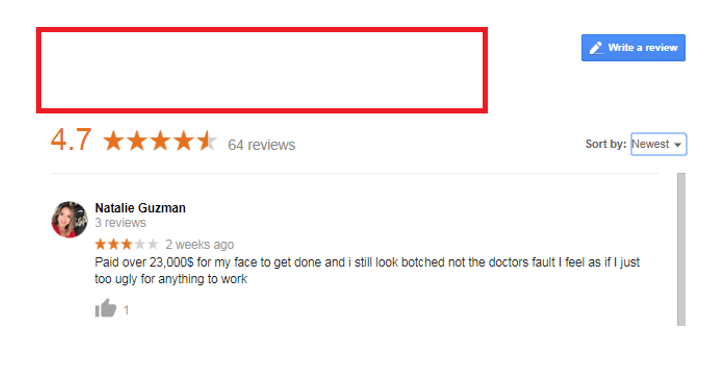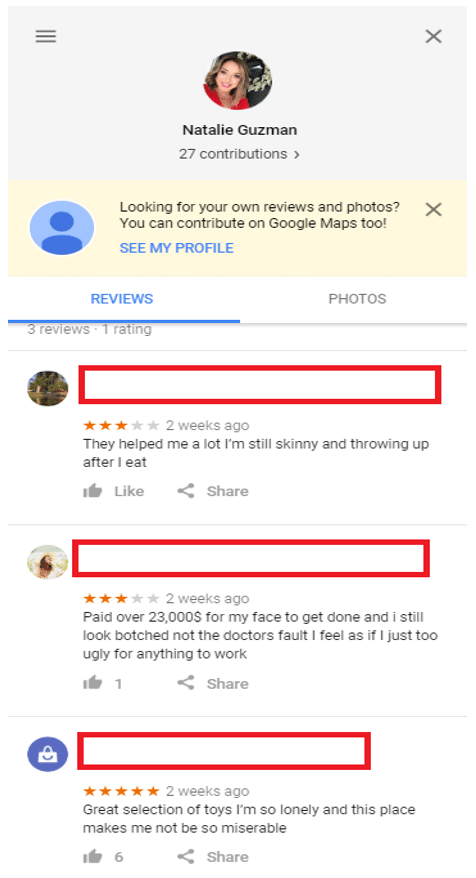by Medical Justice | Jun 29, 2020 | Uncategorized
The Challenge:
A client (an aesthetic surgeon) received a negative review from a “person” calling herself “Natalie Guzman.” Guzman accused our client of charging an unreasonable amount of money for a facelift. The negative review was published on our client’s Google business listing. Our client produced evidence “Natalie Guzman” was not her patient.
The Remedy:
We worked with our client to collect evidence that proved “Natalie Guzman” was a malicious entity and not an actual patient. After bringing this evidence to Google’s attention, they removed the review.
The Explanation:
The review contains two falsehoods. The first is the alleged cost of the procedure – $23,000. The second lie is the identity of the author – “Natalie Guzman.”
To prove the alleged cost of the procedure was inaccurate, we examined our client’s billing practices. They provided us with the average costs of their procedures. It did not approach $23,000.
Next, we examined the profile of the review’s author – “Natalie Guzman.” We discovered Guzman left bad reviews on the profiles of other businesses the same day she targeted our client. And all her review content appeared highly suspicious.
When this evidence was brought to Google’s attention, they took our side – they agreed Guzman’s review content appeared suspicious. The suspect review was soon removed from our client’s business listing.
We’ve included a transcription of our conversation with Google below.
Andrew
3:02PM
Hello! You are now connected to Andrew. Please type your message and hit ‘Enter’ to send.
Thanks for chatting in Google My Business. I’m Andrew, your online specialist, here to help you develop or expand your online business presence! Let’s go ahead and get started. What can I help you with today?
Josh Oldfield
3:04PM
We are confident the review posted by the user Natalie Guzman is a fake review. This person has never been a patient at our practice.
Andrew
3:04PM
Got it, Josh. I’ll investigate this right away.
Josh Oldfield
3:05PM
We have no record of her in our EMR system. No patient has ever been charged the described amount for any facial procedure. To be specific, even our most expensive combination of facial procedures falls short of the amount described: A full facelift and a neck lift is typically $16,190 – much lower than the amount described.
We are willing to provide a screenshot of our billing software, if more evidence is required.
Andrew
3:05PM
That won’t be necessary, Josh. Have you flagged this review already?
Josh Oldfield
3:06PM
Additionally, the author’s delivery seems sketchy. And yes – we have flagged the review.
Andrew
3:06PM
OK – I got it, Josh. I’m going to escalate this review for removal. Please stand by.
Josh Oldfield
3:07PM
Thank you for your help.
Andrew
3:07PM
Josh – I am confirming I’ve escalated the review for removal. I expect I will know more in 24 hours. Can I call you tomorrow?
Josh Oldfield
3:08PM
Yes – tomorrow is good.
The Takeaway:
Contacting Google and declaring a review “fake” may result in a positive outcome for your practice – but you must have evidence. In this example, our communications specialist provided evidence proving the alleged cost of the procedure was inaccurate. He also made a case against the authenticity of the author’s identity. If your practice is navigating a fake review, identify the falsehoods and collect evidence that brings them to light. Or contact us and assign us this responsibility.
We’ll take control and bring Google’s attention to the problem – with solid evidence, removal is likely.
by Medical Justice | Oct 13, 2009 | Medical Justice In The News, Uncategorized
There’s an old adage: The doctor who treats himself has a fool for a patient. That’s doubly true of the patient who treats himself. There’s nothing at all wrong with everyone being well-versed in a variety of subjects, including health care. So what’s the issue? At the bottom line, it’s a matter of objectivity.
A physician considers the patient’s input invaluable to diagnosis and treatment. The patient knows what feels how, where and when, knows when his or her body is “off,” and that helps doctors form a diagnosis. It’s also regularly true that the symptom can be caused by something seemingly removed and unrelated. The correct diagnosis is possible because of the doctor’s training, intuition, and ability to remain objective. If a physician were to only look in the direction the patient suggests, accurate diagnosis would be very difficult indeed.
(more…)
by Medical Justice | Sep 4, 2009 | Uncategorized
Medical Justice Founder and CEO Jeff Segal, MD, JD, FACS recently published an article about Tort Reform on the popular blog KevinMD.
Read Dr. Segal’s article here.
by Medical Justice | Sep 4, 2009 | Uncategorized
As the healthcare debate continues, more pundits, experts and legislatures are coming to the conclusion that real, substantial tort reform must be included in any final reform package. Here are just a few of the comments from around the US just yesterday;
Arizona Sentator John Kyl on FOX News
“And one of the biggest contributors to that is our medical malpractice system, or the lawsuit abuse problem that results in the “jackpot justice” that I wrote about. That is something that the Democratic leadership and the president have been unwilling to address, and the reason is very simple. Howard Dean, former national Democrat chairman, said in a town hall meeting in northern Virginia on August 17th that the reason that tort reform is not in the legislation is very simple. And that is, the authors of the bill did not want to take on the trial lawyers.”
June Bower in the Creston News Advisor
“What is not debatable, however, is that doctors are paying an exorbitant amount of money for malpractice insurance, and they are opting out of performing many medical procedures for fear of being sued. We need their medical services, especially in rural Iowa, and to lose this care hurts us all.
I’ve come to the conclusion it’s shortsighted not to include tort reform in a health care reform bill. What can it hurt? If it makes Republicans happy, why fight it? If that’s what it takes to get a bipartisan bill passed, I say go for it.”
Justin Engle on Mlive.com
“Physicians practice medicine with the burden of excessive medical malpractice insurance and the constant fear of trial lawyers seeking unbelievable and unwarranted cash awards, of which a large percentage goes to the attorney that sued… Physicians often feel pressure to order excessive testing merely to cover their bases and help guard against malpractice claims. This leads to reductions in quality, a less efficient system, and unnecessary and unsustainable financial burdens to society.”
Brett Chase on Portfolio.com
“Historically, tort reform has been a nonstarter with Democrats, who get a lot of campaign money and political backing from the nation’s trial lawyers. But at least one Democrat, former New Jersey Senator Bill Bradley, is suggesting that they let down their guard on this issue to get health reform passed.
“The bipartisan trade-off in a viable health care bill is obvious: Combine universal coverage with malpractice tort reform in health care,” Bradley wrote in a New York Times op-ed.”
Medical Justice has said for years that tort reform makes sense. More and more people are coming to this same conclusion.
by Medical Justice | May 7, 2009 | Uncategorized
Some professional liability carriers are offering discounts to physicians who have implemented electronic medical records (“EMR”). Further, under the stimulus package which was signed into law, doctors who meaningfully use EMR by 2011 will be eligible for federal subsidies up to $44,000 per practitioner. That is a chunk of change.
A number of EMR strategies are competing for acceptance. (more…)
by Medical Justice | Mar 25, 2009 | Uncategorized
Esquire Magazine features a regular column called “What I’ve Learned.” There, a celebrity or a leader in his field, and often in the twilight of his life, reels off a collection of pearls, some well polished, some of little value. I am not famous and my doctor assures me actuarially I am not in the twilight in my life. But, this is what I’ve learned, so far. (more…)



